How Master of Monaco Moss conquered Ferrari, 60 years on
Sixty years ago, Stirling Moss scored one of his greatest victories, defeating the more-powerful Ferraris around the streets of Monaco. Here is the report that appeared in the 19 May 1961 issue of Autosport magazine

Thrilling over 120,000 spectators and millions of television viewers, Stirling Moss in Rob Walker’s 1500cc Lotus-Climax fought off three Ferraris and the Porsche team to win the 19th Grand Prix of Monaco at the record-breaking speed of 113.787km/h (70.77mph).
His was a miracle drive: Richie Ginther, Phil Hill, Jo Bonnier and Wolfgang von Trips did their lot trying to catch the wiry, white-helmeted figure in the dark-blue 1960-type Lotus, who firmly believed that he hadn’t a hope of winning the first of the season’s grandes epreuves.
PLUS: Stirling Moss's 10 greatest drives
The opposition was most formidable, comprising three of the latest Ferraris, two fuel-injected and one ‘carburettor’ Porsche, in addition to the 1961 versions of Lotus and Cooper-Climax. With about 150bhp as against the reputed 185bhp of Ginther’s 120-degree V6 Ferrari, the masterly Moss held off a race-long pursuit, to win from the skilful American by just 3.6 seconds. Stirling took the lead on the 14th of the 100 laps, and thereafter kept in front of the howling pack of Ferraris and Bonnier’s Porsche.
It was a case of Moss fighting on his own. John Surtees put up the best show of all the other British drivers, and was rapidly overhauling von Trips when trouble struck on the 69th lap and the older-type engine of the Yeoman Credit Cooper-Climax seemingly had a tappet break.
The fastest lap of the race was shared by Moss and Ginther, whose 1m36.3s was only 0.1s outside Bruce McLaren’s 1960 record with the 2.5-litre Coventry Climax.
World champion Jack Brabham was never in the picture, and retired after 38 laps with overheating problems. His team-mate McLaren dropped back after running out of petrol at the Gasometer Hairpin.
Jim Clark’s new Lotus was in and out of the pits with carburation and plug bothers. Graham Hill’s BRM broke its fuel pump drive and Tony Brooks’s sister car had engine troubles, after becoming tied up with the exhaust system of Dan Gurney’s Porsche.

Stirling Moss, 1961 Monaco GP
Photo by: Motorsport Images
Bonnier abandoned his Porsche after 60 laps, and Hans Herrmann was delayed with gearbox problems. Von Trips was classed fourth, although two laps from the end he crashed the Ferrari after the throttle mechanism came apart.
Cliff Allison kept his UDT-Laystall Lotus going after the scavenge pump had packed up, but Michael May’s Lotus was retired.
It was probably a good thing from Moss’s point of view that Ferrari waited until the 73rd lap before Romolo Tavoni signalled Ginther to overtake Phil Hill and press the attack home. Hill’s car was beginning to suffer from erratic steering, and his efforts to catch the flying Moss became more of a physical effort every lap.
Qualifying
The blue Mediterranean sparkled in brilliant sunshine when the first training session opened on Thursday. Only Porsche was missing from the line-up, the cars not having arrived in time from Germany.
Brabham had set himself a difficult programme, flying to the USA just after Silverstone, returning in order to practice on Thursday, then off again to Indianapolis for his final qualifying laps, with yet another trip back for Sunday’s race
There was a certain amount of dissatisfaction concerning the method of qualifying for the 16 places in the GP. The 10 actual works entries were assured of places, as were Moss and Maurice Trintignant. Those required to qualify were the UDT-Laystall Lotuses of Henry Taylor and Allison, May in Seidel’s Lotus, Herrmann (Porsche), Masten Gregory (Camoradi Cooper-Climax), Lucien Bianchi and Olivier Gendebien (Emerysons) and Ginther (Ferrari).
The rub was that the four ‘dog-fight’ places each carried only half the starting money that had been guaranteed to the factory men, Moss and Trintignant. Thus the chosen folk could work on the sum of £1000 per car, while the others could not hope to pick up more than £500.
Ferrari was determined to have three cars on the grid. Ginther was given the new 120-degree car; Hill and von Trips had the older-type engines, but even so, there were subtle differences in their cars.
Top 10: Ranking the greatest Ferrari F1 cars
Team Lotus appeared with the 1961 machines, Innes Ireland’s having experimental Dunlop disc brakes.
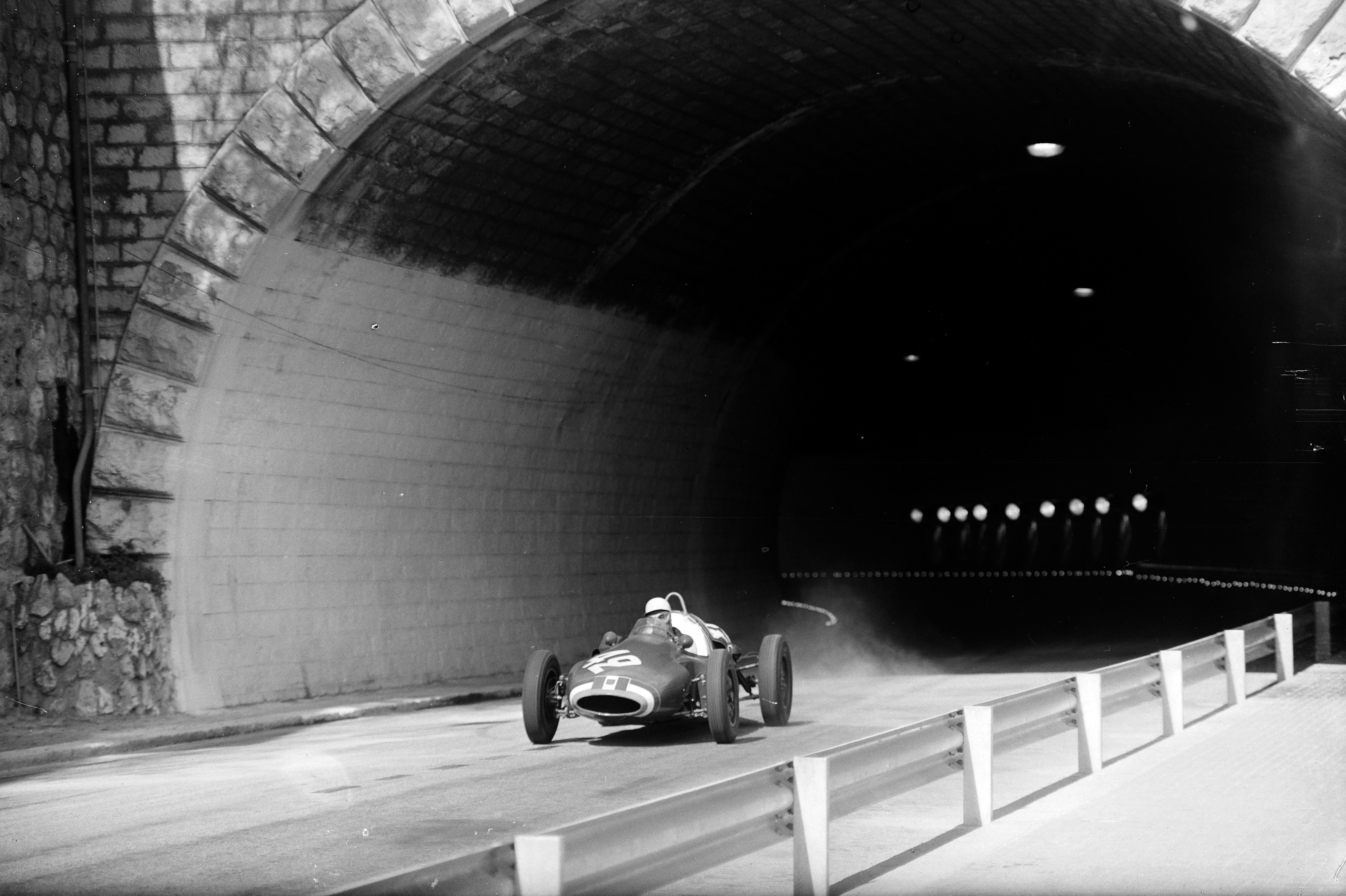
Maurice Trintignant, 1961 Monaco GP
Photo by: Motorsport Images
Brabham had set himself a difficult programme, flying to the USA just after Silverstone, returning in order to practice on Thursday, then off again to Indianapolis for his final qualifying laps, with yet another trip back for Sunday’s race.
Clark’s Lotus made best time of all on Thursday, but shortly afterwards dropped it at Ste Devote, bounced off the anti-crash barriers and finished up on the opposite side of the road with a very bent motor car. The Ferraris were most impressive, and it was fairly obvious that all three would be in the line-up.
Practice really began in earnest on Friday morning, when many bleary-eyed folk came straight out of the night-boxes to watch. There was little sleep for those who had rooms near the circuit, for Gerhard Mitter’s raucous DKW two-stroke engine was being revved up at 0530 just outside the Hotel Metropole.
The Formula Juniors had the first session, then out came the GP machinery. Ginther made sure of qualifying by returning a best time of 1m39.3s. Phil Hill was half a second slower, and Graham Hill (BRM) did 1m40s – 0.3s quicker than von Trips. Ireland did 1m40.5s with the ‘Flying Pencil’ Lotus, and Surtees was fastest of the non-factory people with 1m41.1s.
Bonnier drove two Porsches and returned a 1m41.9s and the Anglo-Swiss May did 1m42s with Seidel’s Lotus. Herrmann put a third Porsche in the running with 1m42.4s. Thus, at the end of the session, the four best for the disputed places were Surtees, May, Herrmann and Allison.
Moss found that the chassis of his alternative car, the Cooper, was about a couple of inches out of true, so decided to drive the Lotus. Without looking in the least as if he was going fast, he returned 1m39.1s.
Ireland had quite a shunt in the tunnel. Apparently, the new Lotus has the gear selectors the opposite way round from the 1960 cars, and Ireland found second gear instead of fourth. He crashed inside the tunnel to emerge with an exceedingly bent motor car. He was taken to hospital with a broken leg and several bruises. Team Lotus worked all night to mend Clark’s car, but Ireland’s machine was completely wrecked.
PLUS: The reluctant Lotus ace who was dropped for Clark

Innes Ireland Monaco 1961 crash
Photo by: Motorsport Images
Surtees, endeavouring to better his already good time, had engine bothers, and Reg Parnell kept his fingers crossed hoping that his rivals wouldn’t get under 1m41.1s. First shock was when Herrmann equalled this, and then May did 1m42s.
After Ireland’s crash, when Moss stopped to make sure that Innes was being looked after properly, there was a hiatus. Gregory had been getting round in 1m43s, scrubbing new tyres and was bedding in new brakes. By the time he was given the OK to get moving, training was over, and Camoradi had lost its chance of having a car on the grid.
Neither Bianchi nor Gendebien qualified the Emerysons, but McLaren made sure of a third-row [on a 3-2-3 grid] start with 1m39.8s with the works Cooper-Climax
The organisers stated that Ireland’s place would not be given to anyone else but, after studying the regulations, they found that they were committed to 16 starters, therefore Allison was in with the UDT car.
Taylor had tried desperately to qualify his Lotus, but a singular lack of hairy horses dropped him 0.3s from Allison’s best. Trintignant did not have to justify his selection, and his best was just 0.2s quicker than Taylor.
Slowest of all was Brabham, whose Thursday effort of 1m44s put him on the back row of the grid. Neither Bianchi nor Gendebien qualified the Emerysons, but McLaren made sure of a third-row [on a 3-2-3 grid] start with 1m39.8s with the works Cooper-Climax.
Porsche decided to put Bonnier and Herrmann in the fuel-injected cars and give Gurney the older carburettor machine.
Graham Hill put BRM among the possibles with an excellent and apparently unhurried 1m39.6s. Brooks did 1m40.1s, just 0.2s better than Bonnier.
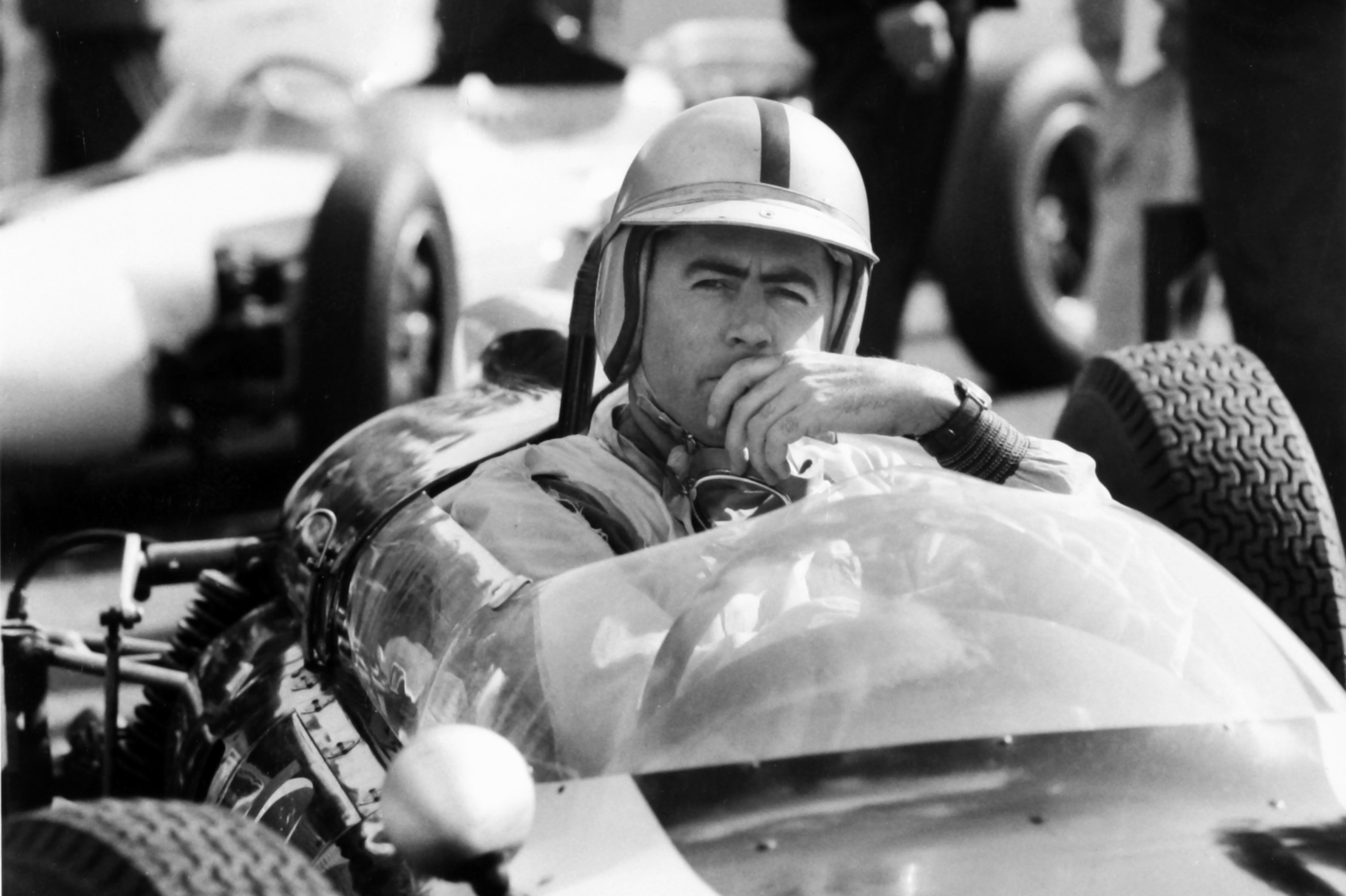
Jack Brabham, 1961 Monaco GP
Photo by: Motorsport Images
Race
There is nothing quite like the Monte Carlo race. As the hour of the depart drew near, thousands of spectators crowded from windows and from every possible vantage point. The harbour was gay with craft dressed for the occasion and, from the decks of an American frigate, scores of white-clad sailors had their own grandstand.
It can be said that Michael Parkes was mainly responsible for the new anti-crash metal barriers that had replaced the unpopular straw bales and wooden poles. It may be recalled that he escaped unhurt when a wheel came off our Rapier in the Monte Carlo Rally eliminating test, and he bounced off the experimental barrier at Ste Devote. The organisers were so impressed that they arranged to erect the barriers all round the circuit.
Brabham arrived from the USA, looking rather tired (and small wonder), after qualifying his Cooper-Climax at 145.14mph at Indianapolis. He was mobbed by newsmen eager to find out the details.
Colin Chapman’s men had done a fine job in repairing Clark’s wrecked Lotus, but all were glum following the news of Ireland’s accident.
Director of the race Louis Chiron closed the circuit in a blue DS19 Citroen, and the 16 starters lined up on the Quai d’Albert. The countdown could be heard clearly over the PA, despite the racket kicked up by Eurovision’s turbo-jet helicopter. Engines were revved up, down came the flag, and the 19th Grand Prix of Monaco was on.
Ginther made a magnificent start and rounded the Gasometer turn first, followed by the usual traffic jam. Everyone managed to sort himself out without undue bumping and boring and, as the field howled past the tribunes, it was Ginther, Clark, Moss and Brooks.
PLUS: Celebrating America's forgotten F1 winner
The passage up from Ste Devote to the Casino was a thrilling sight. Round the square opposite to the Hotel de Paris, down the hill past the Tip-Top and the crowded terraces of the Hotel Metropole screamed the 16. Tyres squealed under vicious braking for the nasty right-hander at Mirabeau, then down to the Station hairpin, out to the promenade and under the notorious tunnel streamed the field, with the red Ferrari in front.
Then came the tricky chicane as the cars regained the sea front, followed by the swerve at the tobacconist’s kiosk and the run down the Quai d’Albert to start all over again.
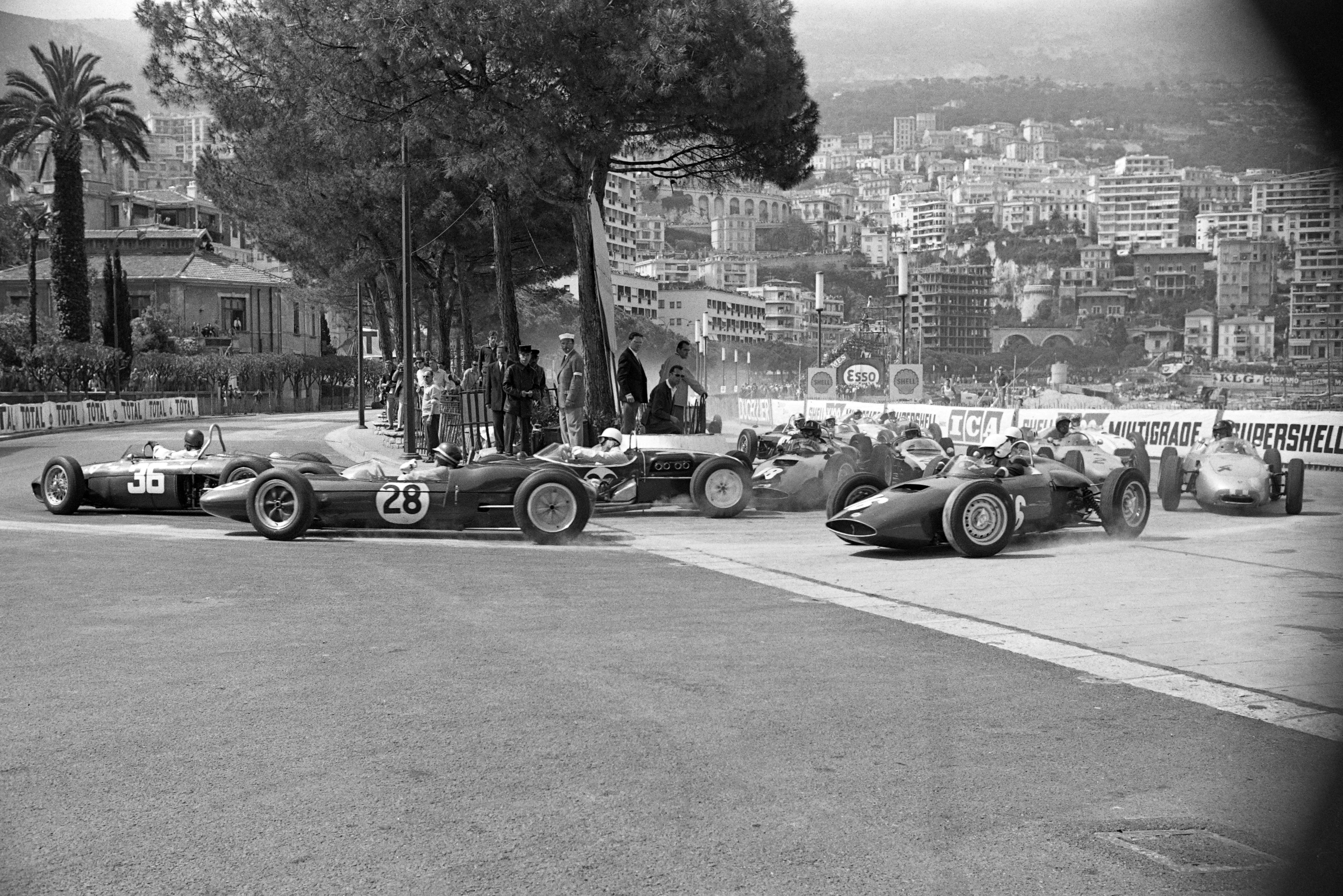
Richie Ginther leads at the start
Photo by: Motorsport Images
Ginther still led, followed 3s later by Clark, Moss, Brooks, Gurney, Bonnier, Phil Hill, McLaren, Graham Hill, von Trips, Surtees, Brabham, Herrmann, Trintignant, Allison and May in that order. All present and correct, what a relief.
As the field reappeared for the second time, Ginther was 4s in front of Moss and there was no sign of Clark. Then as the rest swept by, the low green car went slowly into its pits and mechanics lifted the engine cover.
Behind the leading quartet (Ginther, Moss, Gurney, Bonnier), a dogfight had developed. Brooks, showing his old fire, led McLaren, the two Hills, von Trips and Surtees, each trying desperately to pass one another.
Ginther was driving superbly, but Moss was relentlessly putting on the pressure. Phil Hill moved up over Brooks, to attack the two Porsches, as Surtees stormed past von Trips. Clark eventually restarted, but was forced to call in again.
Moss was now obviously going to take the initiative. The master was making motor racing look absurdly simple, and now he indicated his intention to go in front
Both Moss and Bonnier were breathing down Ginther’s neck, with Hill taking Gurney’s measure, and just biding his time. At the tail end, May had overtaken Allison, and Brabham had moved up over Herrmann.
Moss was now obviously going to take the initiative. The master was making motor racing look absurdly simple, and now he indicated his intention to go in front. Graham Hill’s engine spluttered and banged, and after 12 laps he drew into the pits for the first retirement.
On lap 14, Moss took the lead, and Bonnier followed him through into second place as Ginther gave way. Phil Hill had now taken Gurney, who was being threatened by von Trips; Surtees was giving McLaren no peace.
After 15 laps, Moss led Bonnier by 2s, and had already doubled Allison. Two laps later, the three red Ferraris were in line in pursuit of Moss and Bonnier, who had lapped May.
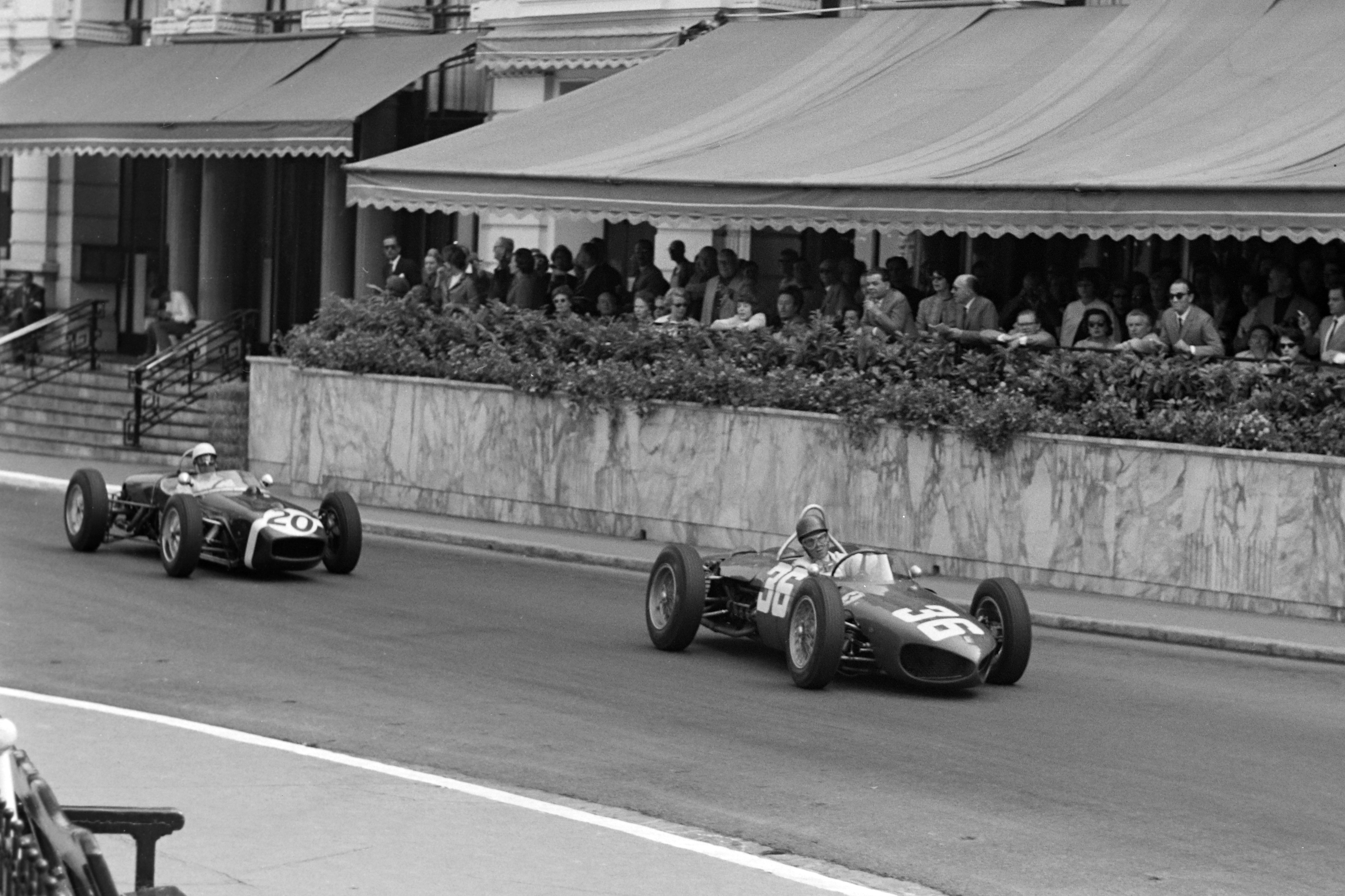
Ginther held a short-lived lead over Moss
Photo by: Motorsport Images
After 20 laps, Moss led Bonnier by 8s, Ginther by 9.2s and Hill by 12.2s. The race average had gone up to 111.08km/h (69.03mph) and Ginther had already recorded 1m39.2s. Five laps later, Trintignant had been doubled, and the unfortunate Clark once again stopped for attention.
Ferrari now gave Hill the sign to take Ginther, for Moss was gradually getting too far away for comfort. Ginther gave way to his team-mate, who thereupon closed right up on Bonnier, whom he overtook on the 27th lap, with Stirling 11.5s ahead.
Top 10: Ranking the 10 greatest Monaco GPs
At 30 laps, Allison had been doubled for the second time, and Herrmann stopped to sort out gearbox problems. Moss led Hill by 9.9s, with Bonnier less than a second behind the American and 2.5s in front of von Trips. Surtees was obviously going to take McLaren for sixth place, and Brooks was duelling with Gurney’s Porsche.
Just as Moss was about to lap Brabham on the 35th tour, the world champion drew into his pits, and remained there. May, who had been driving really well in his first F1 race, stopped with gearbox troubles, was announced as retired, then later re-emerged only to abandon for good.
Ginther covered his 32nd and 35th laps in 1m38.7s and 1m38.4s respectively. Brabham restarted, did three laps, then packed up for good. Moss continued to hold about 10s advantage, while Surtees had taken McLaren’s sixth place, and began his pursuit of von Trips.
On lap 41, Ginther replaced Bonnier in third place, to close up once again on Hill. The race average had shot up to over 112km/h. McLaren, trying to regain some of the ground lost to Surtees, recorded a lap of 1m38.3s.
At half-distance, Ferrari pressure had never relaxed for a moment, but the tantalising Moss still went on his way. An occasional puff of smoke from the rear end worried his supporters a trifle, but was apparently nothing about which to be concerned.
On lap 54 Brooks, attempting to overtake Gurney, somehow became tangled up with the Porsche’s exhaust system. Possibly he knocked his BRM out of gear, but anyway he must have over-revved momentarily, and the second Owen car was out of the race.
Autosport 70: The shambles, success and demise of Britain’s first big F1 team
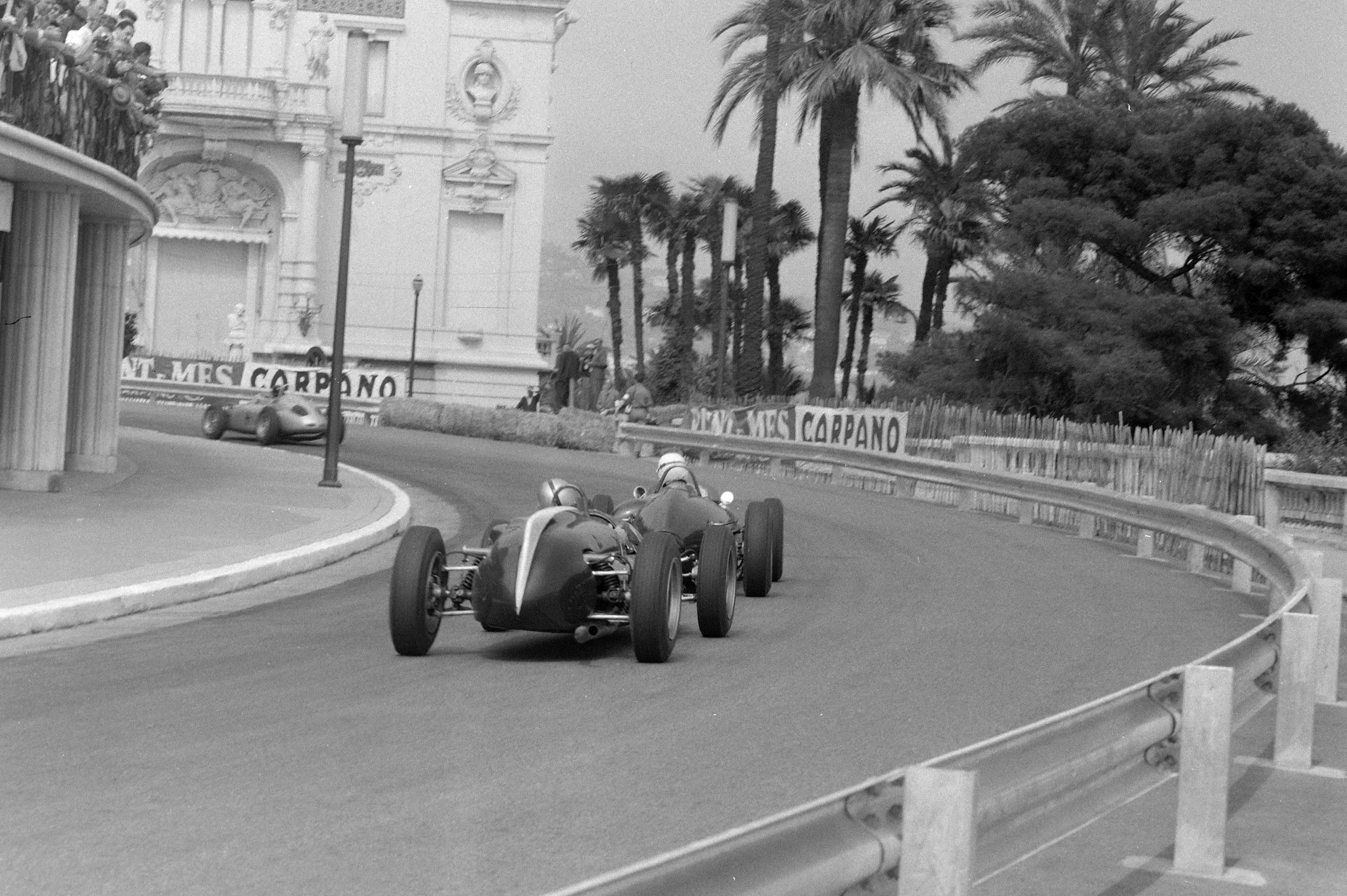
Brooks chases Gurney, 1961 Monaco GP
Photo by: Motorsport Images
Next time round, Moss had doubled Gurney, and Hill had cut the Lotus’s lead to 4s. Surtees produced a lap in 1m37s and was now out to take von Trips.
Just as the 60th lap was chalked up, Porsche hopes were blasted when Bonnier stopped at the station, and started to walk back to the pits. Gurney had, of course, been lapped, while Herrmann was circulating way back behind Trintignant and Allison.
Hill made a desperate bid to get to grips with Moss, getting to within 3.8s of the blue Lotus on the 60th tour. Ginther came up almost level with his team-mate, then dropped behind a few yards – presumably on instruction from Tavoni.
Moss doubled McLaren on his 73rd tour and, a couple of laps later, the New Zealander had also been overtaken by the two Ferraris. Around this time, Ginther was given the sign to mount the assault, and Hill moved over to let him through
It was quite amusing to watch the Ferrari mechanics let Moss go by, before quickly flashing the board to their drivers. They were also worried about Surtees, who was continually a threat to von Trips’s fourth place.
The Moss versus the Ferrari duel continued. On the 70th lap, the gap was 4.9s, and the race average the astonishing one of 112.979km/h. Then came a blow to Yeoman Credit when Surtees slowed, and finally packed up near the station with steam issuing from his exhaust pipe. His had been a fine drive, considering that the engine was, more or less, a 1960 ‘cooker’.
PLUS: John Surtees' 10 greatest F1 drives ranked
Moss doubled McLaren on his 73rd tour and, a couple of laps later, the New Zealander had also been overtaken by the two Ferraris. Around this time, Ginther was given the sign to mount the assault, and Hill moved over to let him through.
Hill’s car was doing more than its share of weaving, so it looked as though the steering department was not altogether 100%.
With 20 laps to complete, something went wrong with the petrol supply on McLaren’s Cooper, and he stopped at the Gasometer Hairpin. He pushed the car to the pits, and more fuel was taken aboard.
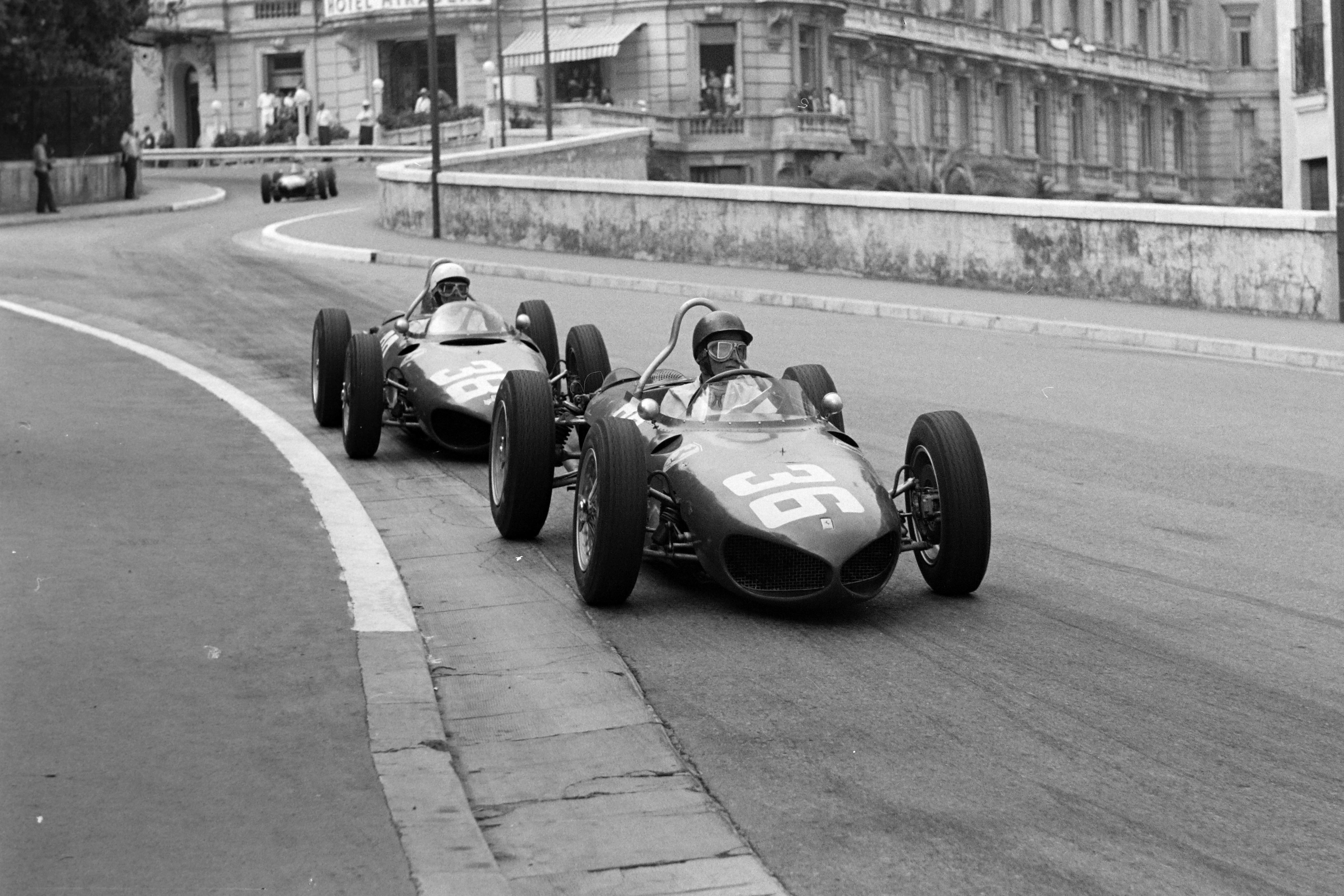
Ginther clears P Hill and sets off after Moss, 1961 Monaco GP
Photo by: Motorsport Images
Herrmann stopped also, and mechanics fiddled about with the engine, before he restarted. His must have been a peculiar sort of Porsche, for the official hand-out stated “Arret de la voiture No. 6 Herrmann – Il repart apres s’etre ravitaille en eau”. Whether the car or driver required water was not quite clear!
As the race went on, tension mounted. “Faster, faster” signalled Ferrari, till finally Ginther had the message “give it the lot”. The young Californian responded magnificently, and returned a lap of 1m36.9s. However, even that wasn’t good enough, so he brought it down to 1m36.3s on lap 84, to come within 3s of Moss. The master replied in typical fashion – he equalled Ginther’s new time.
Von Trips had been in trouble somewhere, for only the three leaders were now on the same lap. McLaren’s pitstop had dropped him behind Gurney, while Allison was circulating slowly with a smoke screen set up by a defective scavenge pump. Trintignant still raced round non-stop in the Cooper-Maserati, outpaced but not disheartened.
People could scarcely contain themselves during the Moss v Ferrari battle. With 10 laps till the end, Ginther was 4.5s behind Moss, Hill 14.6s behind.
Ginther tried everything, but Moss’s racecraft matched the superior speed of the red car. The American could quite easily have thrown caution to the winds, and bet everything on Moss committing an error. However, Mr Motor Racing just doesn’t oblige his rivals in that manner and, even if Ginther had managed to get in front, it was doubtful whether or not he could have stayed there.
With Ferrari almost going berserk in their pits, Moss carried on what had seemed a few days before to be an impossible task. The vast British contingent willed him to win.
Lap 99 and the excitement was so intense that one could almost hear the ticking of countless stopwatches. From the tribunes, all eyes were on the exit from the tunnel. Then, a tremendous burst of cheering rent the air, as the squat little blue car carrying the number 20 whistled through the chicane for the last time, swerved past the tobacconist’s kiosk and, with Moss’s arm raised in a victory salute, took the chequered flag just 3.6s in front of the gallant Ginther in the new Ferrari.
Stirling was mobbed at the end and poor Mrs Moss fell foul of the police trying to get near her son. It was Stirling Moss night in Monte Carlo, the celebrations going on till daylight.
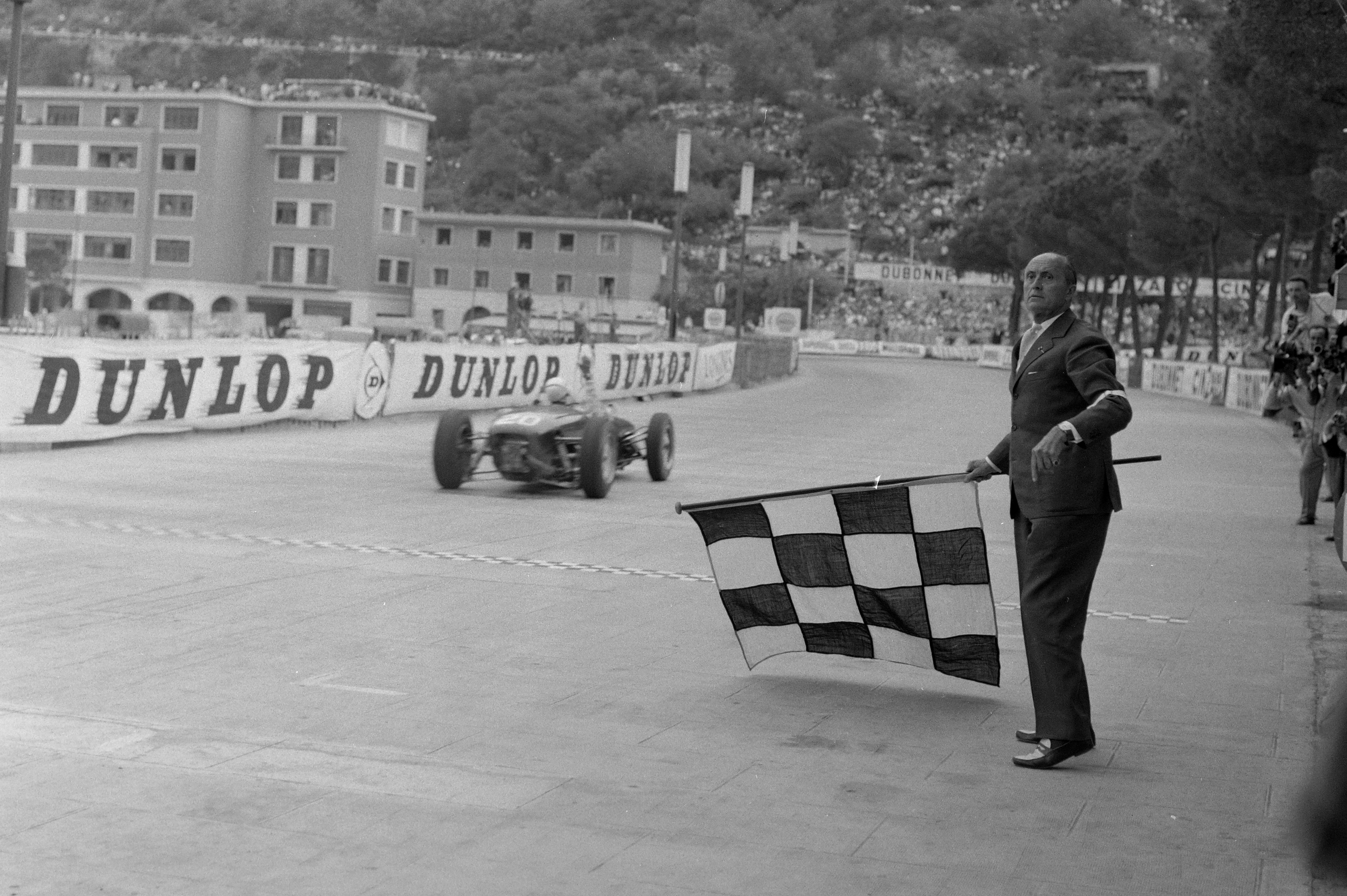
Stirling Moss, 1961 Monaco GP chequered flag
Photo by: Motorsport Images
Be part of the Autosport community
Join the conversationShare Or Save This Story
Subscribe and access Autosport.com with your ad-blocker.
From Formula 1 to MotoGP we report straight from the paddock because we love our sport, just like you. In order to keep delivering our expert journalism, our website uses advertising. Still, we want to give you the opportunity to enjoy an ad-free and tracker-free website and to continue using your adblocker.

















Top Comments